MicroCarb (Carbon Dioxide Monitoring Mission)
EO
Atmosphere
Approved
CNES
Set for launch in late 2023, Carbon Dioxide Monitoring Mission (MicroCarb) is a microsatellite mission by the French Space Agency, CNES, with support from the UK Space Agency (UKSA). Considered a successor to other carbon dioxide missions such as Greenhouse gas Observing Satellite (GOSAT) and Orbiting Carbon Observatory-2 (OCO-2), the objective of MicroCarb is to monitor the fluxes of carbon dioxide between the atmosphere, oceans and vegetation.
Quick facts
Overview
| Mission type | EO |
| Agency | CNES, UKSA |
| Mission status | Approved |
| Measurement domain | Atmosphere |
| Measurement category | Trace gases (excluding ozone) |
| Measurement detailed | CO2 Mole Fraction |
| Instruments | Microcarb |
| Instrument type | Atmospheric chemistry |
| CEOS EO Handbook | See MicroCarb (Carbon Dioxide Monitoring Mission) summary |
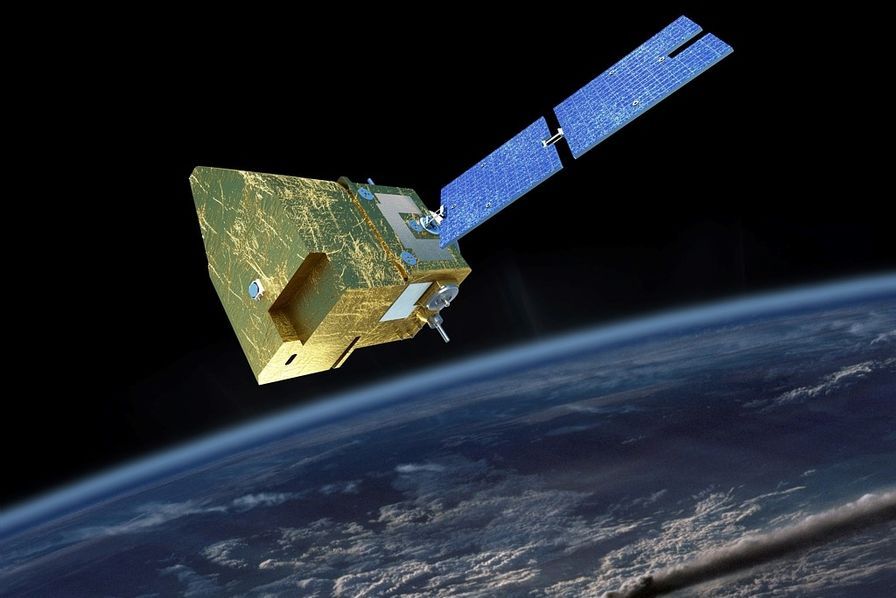
Summary
Mission Capabilities
MicroCarb carries a single instrument, a dispersive spectrometer named Microcarb. The instrument analyses solar light reflected by Earth in four spectral bands in the Short Wave Infrared (SWIR) region to collect data on carbon and oxygen flux concentrations in the atmosphere. The two oxygen absorption bands provide reference information on the contribution of atmospheric aerosols and fine clouds to the radiation observed, enhancing the accuracy of measurements.
The precise data collected for carbon flux aims to fulfil a number of scientific requirements including increasing our understanding of the functioning of vegetation, identifying and quantifying the terrestrial ecosystem carbon sinks and sources at yearly scales, quantifying oceanic carbon sources and sinks on a yearly scale and their responses to announced climate changes, and contributing to the measurement of carbon emission linked to fossil fuels use.
Performance Specifications
The Microcarb spectrometer operates in four narrow bands with a Signal to Noise Ratio (SNR) of 200 and 500 in respective carbon monitoring bands. These high values are necessary in order to restitue the spectra to the required accuracy after measurements are effected by cloud coverage and the scattering of light by aerosols. Microcarb covers a swath width of 13.5 km with a spatial resolution of 4.5 km (cross-track) x 9 km (along-track) for three pointing modes- nadir for over land, glint for over water and target for calibration over ground stations. Its target accuracy for carbon gas measurement is 1 part-per-million (ppm).
MicroCarb is set to undergo a sun-synchronous orbit at an altitude of 650 km and repeat cycle of 21 days. It will feature a Local Time at Descending Node (LTDN) of 1030 hours to reduce the reflection angle and hence optimise the solar flux.
Space and Hardware Components
MicroCarb is being developed on a Myriade Evolutions minisatellite platform adapted to maximise performance within the limits of the mission. It will feature a mass of approximately 190 kg, including 5 kg of hydrazine fuel used by its propulsion module, to support a design life of five years. Microcarb requires 500 Gbit of data transmission per day, and will feature an X-band emitter with a data rate downlink of 150 Mbit/s. Two S-band antennas will transmit Telemetry, Tracking and Command (TT&C) data in S-band.
MicroCarb (Carbon Dioxide Monitoring Mission)
Spacecraft Mission Status Launch Sensor Complement References
MicroCarb is a CNES microsatellite mission with the goal to monitor the fluxes of carbon dioxide (CO2) at the surface between the atmosphere and the oceans and vegetation.
A better knowledge of the carbon flux is needed to: 1) 2)
• Understand the functioning of the vegetation (yearly cycle, response to meteorological anomalies)
• Identify and quantify the terrestrial ecosystem's Carbon sinks and sources at yearly scales (where are the Carbon sinks/sources; how do they evolve with the climate changes)
• Quantify the oceanic Carbon sources and sinks at yearly scales and their responses to the announced climate changes
• Contribute to the measurement of Carbon emissions linked to fossil fuels use.
The idea of MicroCarb is to develop a mission able to compete with large satellite ones in terms of performance while keeping the cost as low as possible. The cost-competitive definition of space systems relies on a consistent balance between satellite performances, system deployment costs and mission user requirements. In particular, the consistency between satellite products and launch services is requisite in order to optimize customer value for money. 3)
The MicroCarb mission is considered a successor to other CO2 missions such as GOSAT/Ibuki of JAXA or OCO-2 of NASA and offers similar performances at improved affordability. Carbon dioxide measurement is based on a dispersive spectrometer working in 4 spectral bands in the SWIR (Short Wave Infrared) domain. Measurements are performed in nadir viewing conditions over land and aiming at the sun glint over the oceans. Additional measurement modes are used for instrument calibration. 4) 5) 6) 7) 8) 9)
The study performed by Airbus DS (formerly EADS Astrium SAS) for CNES has demonstrated that the definition of an ambitious carbon mission, with objectives and performances comparable with those of larger missions, can be envisaged with a microsatellite based on the Myriade Evolutions platform product, at a very affordable cost.
The current global surface network comprises less than 200 stations, unevenly distributed around the world. Because of the sparse number of monitoring stations, the flux inversion problem is highly underdetermined. Inversions thus make use of additional information in their calculation, such as a priori – or first guess - flux estimations.
Spaceborne measurements can provide global coverage, enabling to characterize regional gradients in XCO2 to solve for regional surface fluxes using atmospheric inversion systems as described in the previous section. Satellites have the potential to change the inversion paradigm from the current, data-poor conditions to a data-rich system in the near future.
The two currently flying spaceborne instruments, GOSAT and OCO-2, have been designed specifically for the monitoring of CO2. GOSAT also measures CH4. The observations from GOSAT were invaluable to develop the radiative transfer tools that relate the measured spectra to the CO2 and CH4 columns (Figure 3). Still, some problems in the measurements as well as insufficient spectral resolution did not permit to observe atmospheric signals other than the largest amplitude events. While GOSAT allowed us to investigate the largest XCO2 and XCH4 anomalies, a sensor with higher resolution and higher accuracy is needed in order to detect and quantify smaller-scale anomalies. The OCO-2 mission is making important steps to improve measurement coverage and accuracy. However, OCO-2 does not measure CH4 nor any other gas that may be used to understand the origin of CO2 concentration anomalies.
The rise of atmospheric CO2 concentration is one of the main contributors to global warming. This augmentation is mainly due to anthropogenic emissions. Indeed, only half of anthropic CO2 is absorbed by the ocean and land biomass, while the rest is stored in the atmosphere. Atmospheric CO2 increased by around 118 ppm in concentration between 1750 and 2013, and – as shown in Figure 1 - its yearly average value reached 400 ppm in 2015. 10)
CO2 is the greenhouse gas with the highest contribution to climate change. While its concentration raised in the atmosphere, the mean temperature at Earth's surface increased by 0.9º between 1901 and 2012.
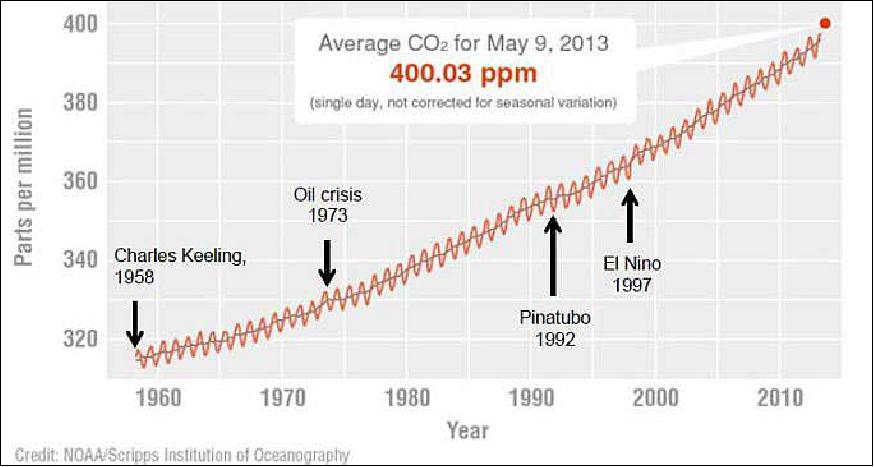
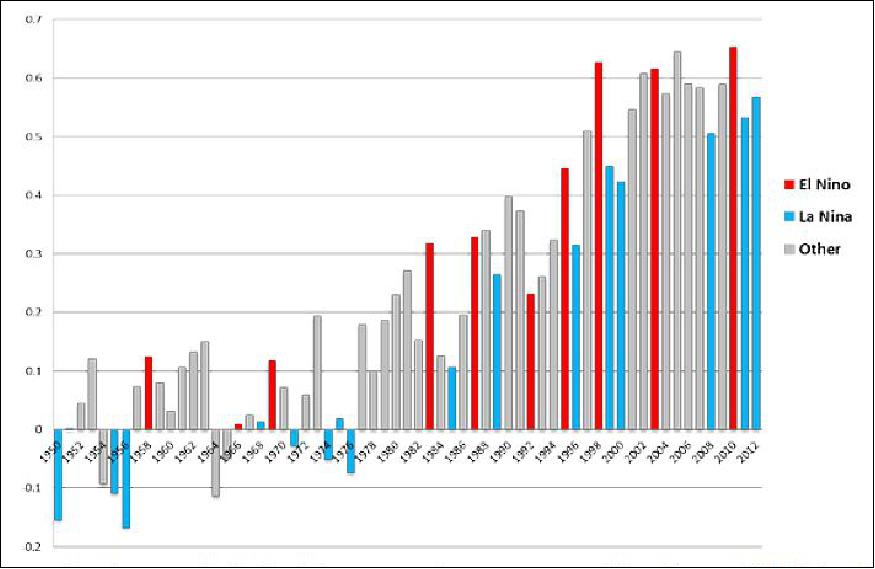
It is essential to continue the monitoring of CO2 from space. The instrument development must benefit from the experience of previous sensors but the continuity of measurements is also essential.

Scientific objective:
The scientific objective of the MicroCarb mission is the monitoring and the characterization of the CO2 surface fluxes, that is the exchanges between the sources (natural or anthropogenic) and the sinks (the atmosphere, the ocean, the land and the vegetation). The annual global fluxes of CO2 represent a quantity of the order of 200 Giga tons of carbon. The emissions due to human activity bring an additional quantity of 10 Giga tons, with the effect of destabilizing the natural balance. This surplus is half absorbed by the vegetation, the land and the oceans, the other half being at the origin of the increase of the atmospheric concentration in greenhouse gases (CO2 is the main of these gases), at the origin of the climate change. MicroCarb aims to be a precursor of a future operational system able to monitor accurately global fossil emissions. 11)
The objective of the MicroCarb mission is to supply a measurement of the CO2 concentration of an extreme precision (of the order of 1 ppm, which is 0.3 %), the spectrum in luminance observed has to be of very high quality: it is then required to have high values for the spectral resolution and for the signal to noise ratio. For a concept of the dispersive spectrometer, as implemented, the required resolving power is between 25000 and 42000.
A sampling mission:
The transport model used for reconstructing the fluxes has a spatial resolution of 2.5º x 3.75 º (or 250 x 400 km at the equator): This resolution can regionally be improved down to 1º x 1º. This model is able to handle 4 dimensions that is the time dimension in addition to the 3 spatial dimensions: it is then able to assimilate data spread over time. MicroCarb is thus sized to allow to sample of every cell of this model in a minimum of time (in fact one week) but not to insure a regular coverage of every single point of the globe.
It will nevertheless be able, as part of an exploratory program, to perform spectral imaging over specific areas (typically urban areas), with a ground resolution of 2 x 2 km2, instead of the nominal resolution of 40 km2.
Nadir scanning:
Over land surfaces, the satellite will perform acquisitions at nadir. A scanning mechanism will authorize pointing the line of sight on either side of the satellite track with an amplitude of ± 200 km, thus increasing the acquisition of not correlated measurements.
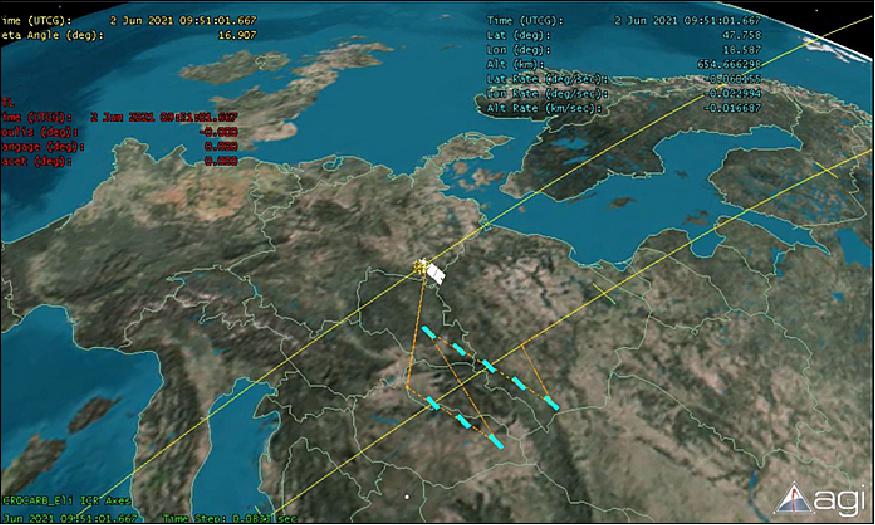
Solar glint tracking:
Over the seas, the water being dark in the spectral domain of the near-infrared and thus not reflecting the sunlight, MicroCarb will aim at Glint, which is the reflection spot of the sun, instead of nadir. This capacity of tracking the Glint permits obtaining a sufficient level of flux coming in the instrument and thus authorizes the measurement of the concentration of atmospheric CO2 over the oceans.
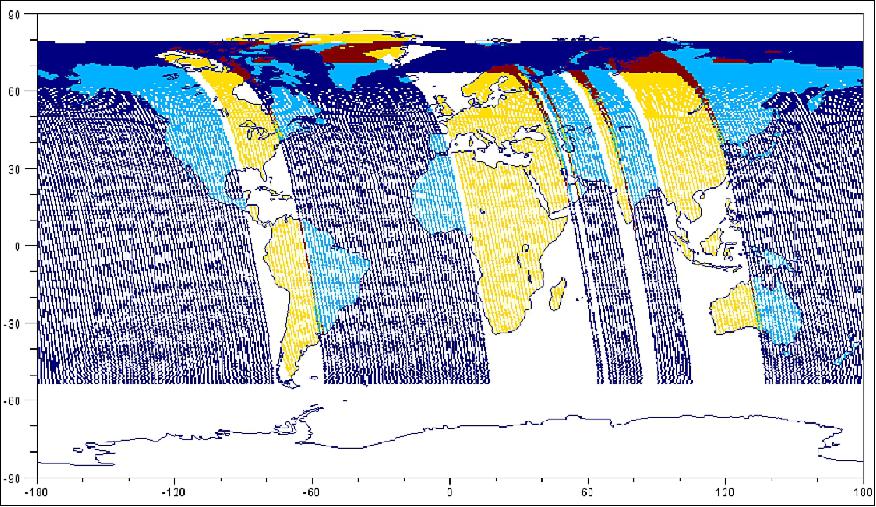
Legend to Figure 5:
The figure shows a possible distribution between Glint and Nadir modes. Orbits in blue are in Glint (orbits mainly on sea), while orbits in yellow are in Nadir mode. It is also possible to have part of an orbit in nadir pointing and another part in glint. Nadir pointing is made by the satellite along the pitch axis and thanks to the scanning mechanism, along the roll axis.
Target pointing:
The last observation mode consists of permanent acquisitions on a fixed target. This mode is in particular intended to allow the verification of the accuracy of the concentration assessment by comparison with the measurements performed by ground stations (belonging to the TCCON network). This operative mode will also be used to complete high-resolution cartography over specific areas with dimensions of dozens of km of the surface. In this mode, the movement around the pitch axis is provided by the satellite, while the movement of the roll axis is provided by the scanning mechanism internal to the instrument.
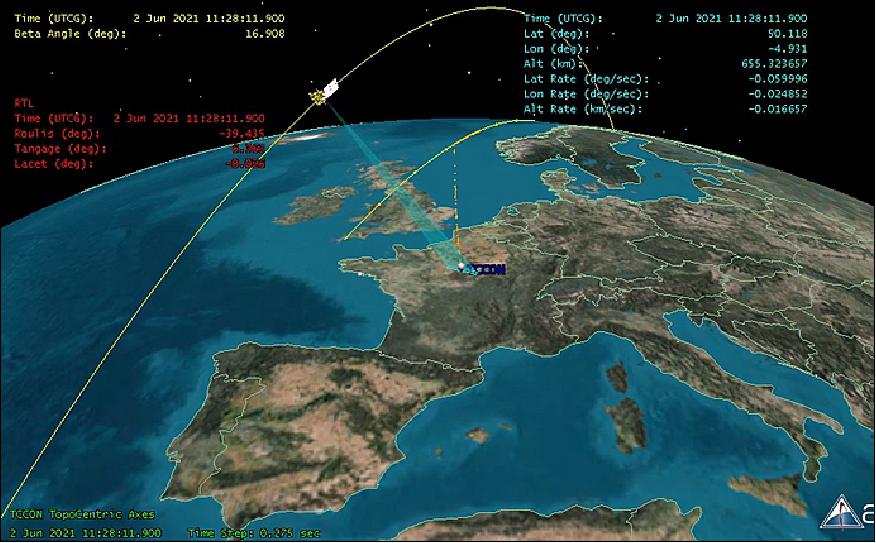
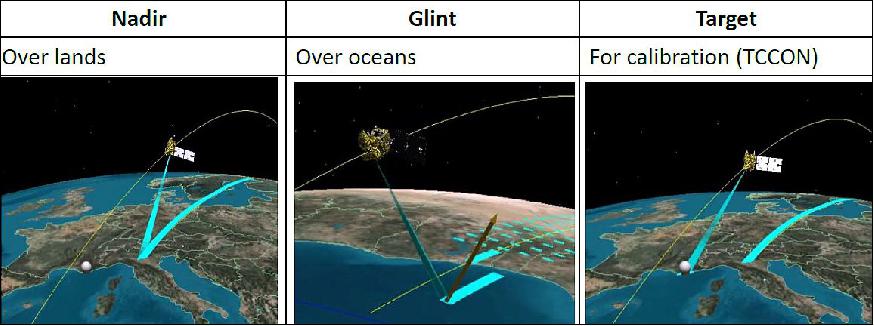
Spacecraft
The MicroCarb minisatellite is being developed on a Myriade platform, which is entirely reused with adaptations limited to standard mission activities. In particular, the standard architecture offers the dependability and agility needed to ensure pointing in glint and target modes with no need for modification, despite the highly required pointing angles. The satellite is fully compatible with a launch as a passenger in the external (microsatellite) position on the Soyuz ASAP-S structure. 13)
The Myriade Evolutions minisatellite product line objectives are to maximize mission performances within the limited resources.
The requirements call for:
- Satellite mass: ~190 kg
- Satellite power: 200 W
- Mass memory: 800 Gbit
- Telemetry data rate: 156 Mbit/s
- Propulsion: 80 m/s
- Design life: 5 years.
The MicroCarb satellite mass is estimated to be about160 kg, including 5 kg of hydrazine (Ref. 10). The size of the satellite is 600 x 800 x 1000 mm with a power average of 110 W.
Performances offered to the payloads:
- Mass: up to 80 kg
- Power: 60 W permanent (orbit with eclipse)
- Pointing: accuracy < 5 x10-3 º, stability < 2 x10-2 º
- Telemetry rate: 400 kbit/s
- High rate telemetry: 16.8 Mbit/s
The MicroCarb payload has a mass of 63 kg, a size of 600 x 800 x 400 mm, an average power of 57 W and a data transmission requirement of 500 Gbit/day.
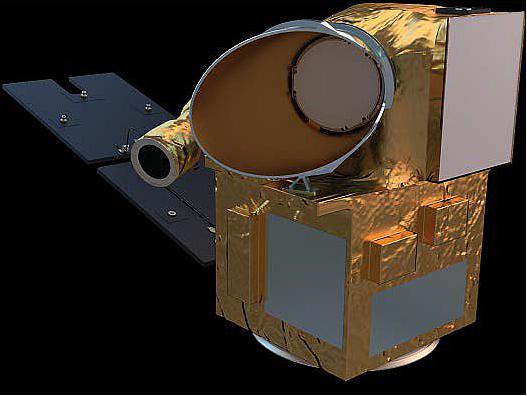
OBC (On-Board Computer) upgrade:
The main obsolete item was the Central On-Board Computer processor T805. In order to deal with this obsolescence without redeveloping a brand new central computer, it has been decided to emulate the processor in an ASIC called LENA (Figure 9), developed under CNES contract. This ASIC foundry is now finished and it has successfully been tested in the overall computer and with the generic Myriade On-Board Software.
On top of this ASIC, the overall On-Board Computer has been renewed in order to:
- double the CPU capacity
- increase the RAM
- Provide additional interfaces for flexibility to payloads, on top of the OS-link native link: (MIL-1553, SpaceWire, BRIO bus, UART)
- upgrade TM/TC boards.

On top of these standard Myriade platform evolutions, a specific one is added for MicroCarb: the high-capacity mass memory. The MicroCarb instrument is rather simple i.e. with no complex processing. Atmospheric absorption spectra as recorded on the detector are almost fully downlinked to the ground for further L1 processing. Therefore, the amount of data generated by the payload is around 500 Gbit/day, which is huge for a microsatellite.
The previous capacity of the generic Myriade mass memory (16Gbit) was definitely not sufficient to meet MicroCarb needs. Hence, it was decided to develop a "combo" version of the On-board Computer, merging the OMER-E2 computer with a specific UPM-1T mass memory card. This UPM-1T card is inherited from ongoing development held by Steel for Myriade Evolution platform. It will provide a mass memory capacity of 800 Gbit at EOL, with power consumption as small as 3 W on average (for mass memory only, 10 W for overall OBC-Combo), which complies with a very tight MicroCarb power budget.
AOCS upgrade:
The AOCS evolutions are mainly driven by mission performance requirements. The first one is the agility required by the mission. Indeed, despite the implementation of a Sight-Changing Mirror in the instrument allowing for across-track agility, along-track agility is challenging. Myriade platform had 3 very small wheels (0.12Nms Teldix) aligned with the satellite axis for normal operations, and an additional one for safe mode. MicroCarb inertia being increased with respect to the generic Myriade bus, the agility allowed by 1 wheel was not sufficient to perform target mode in particular around the pitch axis.
It has then been decided not to change the wheels but to use 4 wheels in the skewed configuration in order to:
- increase pitch agility
- allow 4/3 hot redundancy.
The pyramid is oriented towards the pitch axis with a 45° angle tilt, allowing to augment torque/momentum capacity by more than 2.5 with respect to a configuration with only one wheel on this axis (Figure 10). Even with one wheel failed, it will be possible to perform the target mode.
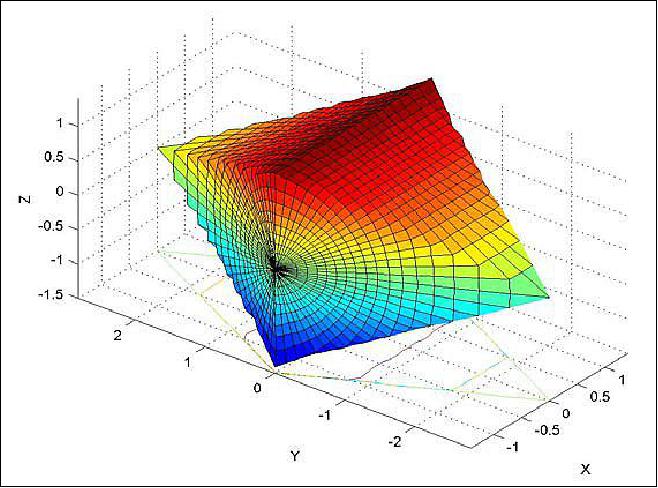
In addition to wheels configuration modification, it has been decided to move towards a gyroless AOCS in order to:
- manage gyro obsolescence
- save space inside the platform
This evolution is made possible by the availability of new star trackers such as Hydra-M from Sodern which provides better robustness to Moon-blinding and to temperature constraints, as well as better measurement performances than the current baseline Myriade's Star Tracker.
In order to meet geolocalization needs coming from the mission (around 400 m overall), and possibly to implement an autonomous guidance subsystem, it is required to get a precise on-board orbit coming from embarked GNSS receiver. The most adequate receiver identified for MicroCarb, in particular for what concerns low power consumption is the Skyloc receiver from Syrlinks.
All these hardware modifications will have to be backed with On-Board Software evolutions to manage in particular the gyroless AOCS mode, as well as its associated FDIR (Failure Detection, Isolation and Recovery) and a specific safe mode with two wheels instead of one.
Propulsion upgrade:
The Myriade bus is equipped by default with hydrazine propulsion module provided by Airbus Defense and Space.
It will have to be modified for MicroCarb for two reasons:
- debris risk mitigation rules
- REACH (Registration, Evaluation and Authorization of CHemicals) evolution compliance (TBC).
The French Space Operations Act voted in 2010 will be, after a "best effort" phase, fully applicable by end of 2020 to all satellites operated from France. It requires passivating the satellite after its operational life and to put it on an orbit leading to an atmospheric reentry within 25 years (this is applicable for very small satellites that represent a casualty risk smaller than 10-4 which is the case of MicroCarb). The propellant budget has been computed in order to account for the orbit decrease (from 649 km altitude mission orbit to typically 620 km altitude) at end of life.
But the Myriade design did not allow it to passivate the tank at the end of its life. Indeed, pressurant gas is trapped upstream of a membrane even after the propellant drain. Therefore, a microperforator will be added to the tubing between the tank and the gas fill and drain valve. This microperforator under development in Lacroix (with CNES funding) will be qualified by end of 2016 (Figure 11).
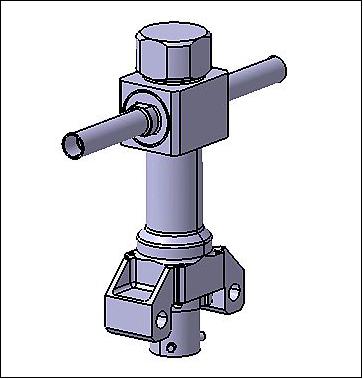
The REACH issue is still TBC. Indeed, hydrazine does not yet belong to the forbidden material list but it is on the candidate list. It might be inserted into the forbidden list in the coming years which will make it difficult or even impossible to use the current propulsion system. Alternative solutions are under analysis in order to get full REACH compliance. We will take the opportunity of these modifications to improve the performances of the propulsion sub-system, in particular for what concerns the total available ΔV.
Power subsystem upgrade:
Here again, the required evolutions are linked with equipment obsolescence and debris risk mitigation but can be the opportunity to improve the performances of the subsystem. An existing ABSL battery with Sony HC cells is no longer available, it is therefore envisaged to use a new battery, still to be selected, which will take benefit from the latest Li-Ion technology improvements. Hence, it is expected to get additional power storage capacity within the same mass/volume budgets, allowing it to cope with MicroCarb demanding power budget, in particular in cold cases.
The last evolution of the power subsystem is the modification of the PCDU (Power Conditioning and Distribution Unit) which will have to be modified to allow for electrical passivation at end of life. This modification is required by the French Space Operations Act to avoid battery recharging (along with explosion risks) after the satellite switch off. A specific relay will be activated to completely disconnect the battery from solar arrays and thus forbid any recharging. The solar cells can also be upgraded for the next Myriade missions while keeping the existing PCDU. However, CNES intends to use for MicroCarb a solar array in storage that fits the mission needs.
RF communications subsystem upgrade:
The single evolution implemented on this subsystem is a new X-band emitter implementation. This new emitter under development by Sirlinks for the Myriade Evolution platform is able to reach a high data rate compatible with the MicroCarb needs. Indeed, in order to download 500 Gbit/day with a limited number of passes (typically 4 to 5), the data rate has to reach roughly 150Mbit/s which is possible with the selected equipment. Moreover, this equipment is fully compatible with UPM-1T mass memory board and no development is therefore necessary. The power consumption is, however, quite high (>50 W) which puts constraints on the bus accommodation due to high dissipation.
The external satellite accommodation for MicroCarb is described in Figures 13 and 14. All the appendices (brackets, sensors, baffles, antennas and solar array) take up most of the space on the platform walls. The remaining surfaces for thermal radiators are very limited but fulfil the heat rejection needs. The star tracker optical head is positioned on the payload module deck in order to reduce thermoelastic distortion between the AOCS reference and payload line of sight.
Two S-band antennas are placed on Earth (nominal operations) and zenith (safe mode) faces. One X-Band antenna is placed on Earth's face while the GNSS antenna is pointing towards the zenith with a slight tilt angle (18°) in order to avoid maskings coming either from payload or star-tracker baffles. Three sun sensors are accommodated all around the satellite in order to get a 4π steradian coverage for safe mode.
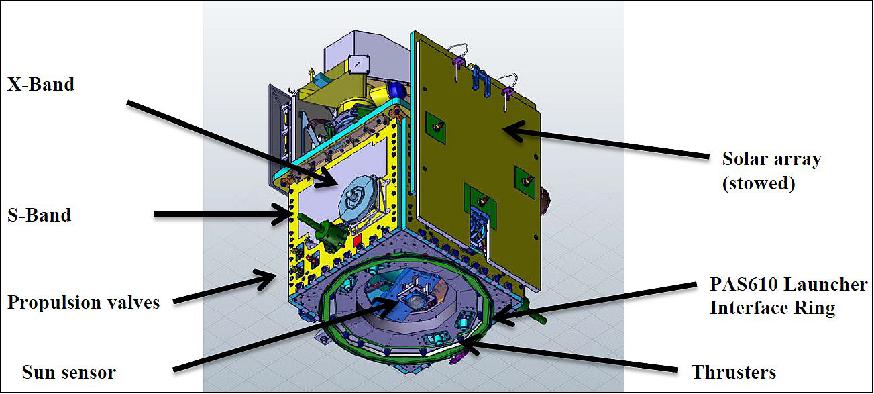
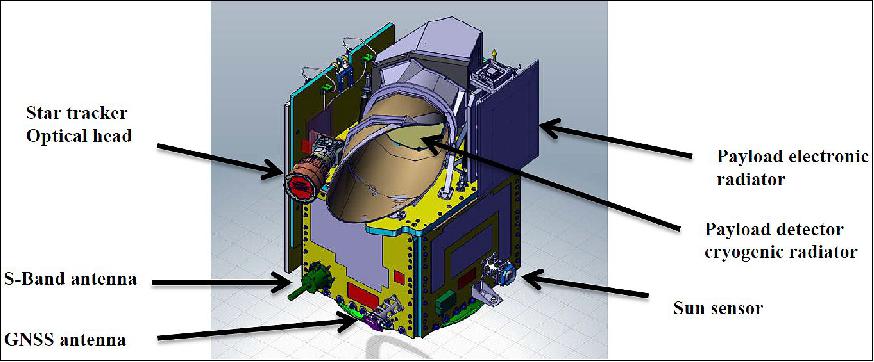
Launch
Arianespace has been awarded a launch contract by ESA, on behalf of the European Commission, to launch Microcarb in 2023 on Vega C. Microcarb is a 190 kg minisatellite developed by CNES that will be delivered into a sun-synchronous orbit, 650 km above the Earth. 18)
- "We are very proud of this new launch contract, which underlines the capacity of Arianespace to design the most competitive launch solutions, here with Vega C, to address the needs of European institutions", Stéphane Israël, CEO of Arianespace, declared. "We are particularly thrilled to make this iconic project a reality, which is a great example of cooperation between ESA, the European Commission and CNES, with the support of the industry, to better understand the impact of human activity on climate change".
Orbit:
The choice of the orbit is dictated by the scientific objectives while taking into account the optimization for launch opportunities as a piggy bag and the rules governing space debris mitigation. The selected orbit is a Sun-synchronous orbit with an altitude of 650 km and LTDN (Local Time at Descending Node) at 10:30 hours. The choice of the local time allows for optimizing the solar flux (reduction of the reflection angle). The choice of altitude optimizes the homogeneity of the coverage at the horizon of one week. The system still remains compatible with a change of the local time (13:30 hours).
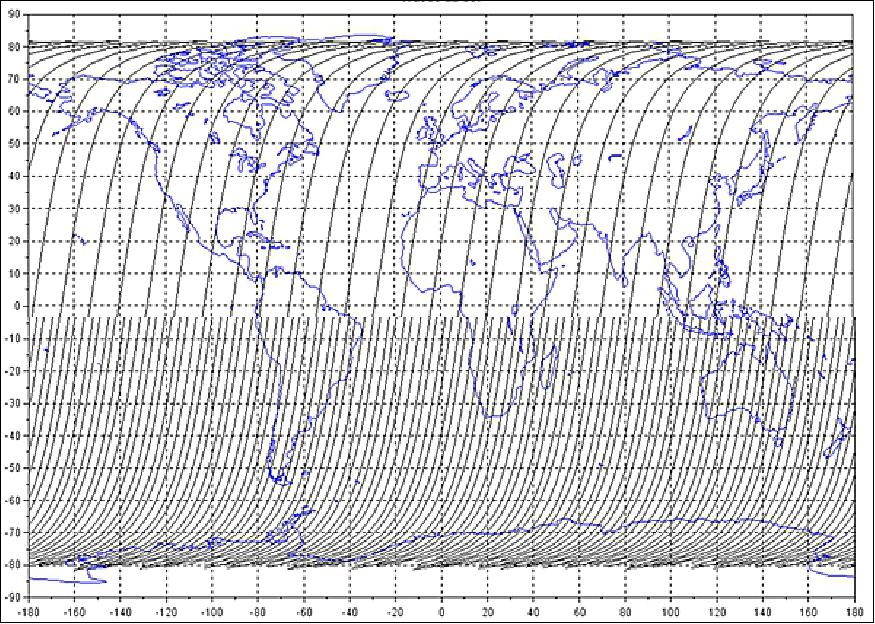
Mission Status
• December 22, 2020: Two major subsystems of a joint France-UK space mission to combat climate change, by measuring carbon dioxide concentrations, have been delivered from the UK to Toulouse. 14)
- Due for launch in 2022, the mission will monitor and map sources and ‘sinks' of carbon gases, as well as support the Space Climate Observatory – one of the significant parts of the Paris Accords. It will be the first European mission intended to characterize greenhouse gas fluctuations on Earth's surface and gauge how much carbon is being absorbed by oceans and forests, the main ‘sinks' on the planet.
- Humans are currently adding billions of tons of carbon dioxide to the atmosphere every year, primarily from the burning of fossil fuels, and about half of this sum stays in the atmosphere where it drives global warming. Half of the remaining half is absorbed into the ocean, with the remainder pulled down into these ‘sinks' – but our ability to track how much is in each source is very limited.
- MicroCarb will play a pivotal role in international efforts to quantify just how much CO2 is being emitted by natural processes and by human activities.
- The onboard Pointing and Calibration System (PCS), developed by Science and Technology Facilities Council's RAL Space, and the optical test suite, developed by UK National Physical Laboratory (NPL), have both been delivered to Airbus Defence and Space, the prime contractor of the MicroCarb Instrument.
- Dr Graham Turnock, CEO of the UK Space Agency, said: "The inventiveness and ingenuity that exists in the UK's space sector is on full display in these instruments. They mark another exciting step forward in our collaboration with France on this vital mission to take the fight to climate change. Space is playing an increasingly crucial role in our efforts to monitor and combat climate change and MicroCarb, the first European mission to measure sources and sinks of carbon, will arm us with the insights we need to help make Earth a healthier place."
- CNES President, Jean-Yves Le Gall, added: "The battle to curb climate change is a key strand of space cooperation between France and the United Kingdom. MicroCarb is a testament to our two nations' commitment to take up this major challenge of the 21st century. With its cutting-edge instruments, the MicroCarb mission will deliver deeper insights into the effects of human-induced CO2 concentrations in our atmosphere."
- The in-flight PCS which is the entry port of the instrument and includes two onboard calibration sources, the White Lamp Subsystem and the Sun Diffuser, which will be integrated inside the instrument in January 2021.
- Optical ground support equipment will be used all along the integration and qualification phase as a reference for absolute instrument calibration and highlights the UK's role in the underpinning of data quality and veracity both pre-flight and in-flight.
- In recent years, space collaboration between the UK and France has gone from strength to strength through the SWOT, IASI-NG and now MicroCarb programs. The UK Space Agency, the Centre National d'Etudes Spatiales (CNES), Airbus Defence & Space, RAL Space and National Physical Laboratory are working together on the first European CO2 monitoring spectrometric instrument from space.
- From 2022, MicroCarb will be able to measure the total column concentration of carbon gas with a high degree of precision, on the order of 1 ppm and with a pixel size of 4.5 km x 9 km. Carrying a more compact instrument almost three times lighter than OCO-2's, MicroCarb is built around a CNES Myriade microsatellite bus and will perform local measurements of carbon gas concentrations in zones of intense human activity.
• October 2019: The project actors and progress (Ref. 13).
- CNES is acting as the system and satellite development prime, performing the design, the integration and the tests at both system and satellite levels; CNES will also operate the system.
- CNEs established a partnership with UKSA to share the development effort. UKSA is particularly involved in the satellite Assembly Integration and Test process, with the support of Thales Alenia Space UK.
- CNES awarded to Airbus Defence and Space a contract for the development of the instrument.
- EUMETSAT and CNES have an agreement under which EUMETSAT will run the processing chains delivered by CNES and elaborate and store and disseminate the different products. The products will be made available to the international science community as soon as validated.
- CNES also takes profits from the support of the European Commission (EC) and the European Space Agency (ESA), fully involved in the success of the program.
- Different national research laboratories (Laboratoire des Sciences du Climat et de l'Environnement, Laboratoire de Météorologie Dynamique, Laboratoire Atmosphères, Milieux, Observations Spatiales) belonging to the French Centre National de la Recherche Scientifique or Commissariat à l'Energie Atomique or Ecole Polytechnique and British Universities (the University of Leicester and the University of Edinburgh) lead the scientific expertise of the project and get prepared for the scientific exploitation of the data products.
• November 9, 2017: Thales Alenia Space, a UK company, has been selected to undertake the AIT (Assembly Integration and Test) functions for the MicroCarb satellite, which will help tackle climate change. The contract was signed by Ben Olivier, CEO of Thales Alenia Space in the UK and Jo Johnson, Science Minister. MicroCarb is a joint UK-French satellite mission which will measure sources and sinks of carbon, the principal greenhouse gas driving global warming. 15)
• April 19, 2017: The UK and French space agencies have reached a ground-breaking new agreement to work together to tackle climate change. The Agency's Director of Growth, Catherine Mealing-Jones, and CNES President, Jean-Yves Le Gall, signed the MicroCarb cooperation agreement at the French Ambassador's Residence in London. 16)
• In April 2016, CNES awarded a contract to Airbus DS to design and build the optical instrument for MicroCarb. 17)
• MicroCarb program decided: The decision was announced by the French government at the UN COP-21 (Conference of the Parties) in Paris, France, on Dec. 8, 2015. The development is conducted by CNES with European partners.
• The MicroCarb project is in Phase B as of 2016.
• Organization actors: MicroCarb has been defined by CNES in collaboration with French research laboratories from CNRS and CEA.
- Laboratoire des Sciences du Climat et de l'Environnement (F. M. Breon, PI)
- LMD (Laboratoire de Météorologie Dynamique)
- Institut Pierre Simon Laplace
- Laboratoire Atmosphères, Milieux, Observations Spatiales, and others
• Funding is provided by the French program "Investment for Future".
Sensor Complement
The objective of the MicroCarb payload is to measure the solar light reflected by the Earth's surface in the near-infrared. The solar spectrum is modified by the atmospheric CO2 molecules (CO in option) as shown in Figure 15.
Note: The methane band was recently removed. Hence, MicroCarb will no longer measure CH4. 19)

The instrument will be able, thanks to a very high spectral resolution, to precisely measure the absorption in 4 bands. As an additional option, another band for O2 and a band gathering H2O and CO and it will then be possible to derive the CO2 concentration in the air column below the satellite.
The atmospheric-sounding instrument for MicroCarb is a dispersive spectrometer, using a reflexive grating for spectral bands dispersion.
The main design characteristics (requirements) of the instrument are as follows (Ref. 4):
• High signal-to-noise ratio combined with a high spectral resolution in order to achieve accurate CO2 measurements
• A spatial resolution better than 50 km2 over several across-track pixels in order to maximize the odds of cloud-free pixels acquisition
• A polarization-free design (lower than 0.1% in both nadir and glint modes), allowing for improved signal-to-noise ratio in particular over the oceans
• An extensive on-ground characterization and in-flight calibration concept to reach the required measurement accuracy
• A built-in cloud imager to allow discrimination of cloud-contaminated pixels.
The instrument is a passive spectrometer operating in the SWIR (Short Wave Infra-Red) domain of the spectrum. It operates in 4 narrow bands. An imager is embedded and contributes to the detection of clouds in the direction or close to the direction of the sounding.
Number of spectral bands | 4 | |||
Central Wavelength of the spectral bands (nm) | 764 | 1608 | 2037 | 1273 |
Bandwidth (nm) | 10 | 17 | 22 | 27 |
Observed gas | O2 | CO2 | CO2 | O2 |
SNR | 480 | 680 | 325 | 670 |
Spectral resolution | 25,000 | |||
Spectral bands | B1: 0.76 µm (O2) |
XCO2 measurement accuracy | Bias < 0.1 ppm; Random noise < 1 ppm |
Resolution power (λ/Δλ) | ≥ 25 000 for each band |
IFOV (Instantaneous Field of View) | 3 IFOVs: size 4.5 km (cross-tracvk) x 9 km (along-track) simultaneously acquired at nadir |
Swath width | 13.5 km (which results from 3 soundings of 4,5 km width each after processing) |
Spectral sampling | > 2.8 |
Pointing modes | Nadir: overland |
SNR (Signal-to-Noise Ratio) | 200 (B4), >500 (B1) |
The simple and compact architecture baselined for the sounder as well as the reuse of off-the-shelf components wherever possible allows defining of an instrument compatible with both a microsatellite concept with a launch mass lower than 200 kg and an affordable implementation budget. The instrument requirements call for a mass of < 70 kg with an average power demand of 57 W max, and it globally fits within an 80 cm x 60 cm x 40 cm volume.
Spectrometer
The measurement relies on the utilization of a passive SWIR (Short Wave InfraRed) spectrometer which analyzes the solar light reflected by the Earth. This light crosses the atmosphere 2 times, during which it is partly absorbed by the gaseous species present in the atmosphere. The solar spectrum is then modified and absorption rays appear at the wavelengths specific to the molecules encountered. The depth of these rays is directly led by the quantity of absorbing molecules.
The measurements are then limited to the part of the orbit with sufficient solar reflected flux (high latitudes are excluded, with low impact on the scientific benefit).
Clouds and aerosol presence need to be considered:
clouds will block out the Earth's surface, then annealing any measurement, while aerosols will reflect and scatter the solar light, then usually bringing to underestimate the actual quantity of CO2. High values of spectral resolution and Signal to noise ratio are necessary in order to restitute the spectra with the required accuracy.
Instrument concept and requirements:
The definition of the instrument concept is driven by the requirement for compactness and by the radiometric and spectral performances. The spectrometer relies on a dispersive concept, using a unique blazed (echelle) grating element at different orders of diffraction. These orders are fit to the wavelengths of the measurement bands.
An original device permits to multiplex of the different diffracted channels on a single detector. One dimension of the detector is dedicated to the spectral dimension of each band. The other dimension of the detector permits both to image the field of view, as limited by the spectrometer entrance slit, and to place side by side different bands. Binning of the different pixels along the spatial axis in each band permits to improv the SNR.
The projection on ground of this slit is close to 0,4 km (along track) x 12 km (cross track), and is separated in 3 IFOVs (Instantaneous Field of Views). The spectrometer forms sharp monochromatic images of this slit on the detector array for the 4 bands as illustrated in Figures 16 and 17. The measurements are then integrated during 1.5s together with the satellite ground track motion. After this integration, the measurements downloaded to the ground represent a spatial resolution of 4.5 km (cross track) x 9 km (along track).
The detector is a 1k x 1k HgCdTe matrix (Sofradir NGP). Cooling of the focal plane at 150 K is achieved thanks to a passive system with a cryogenic radiator directed towards cold space and protected by a shield from the sun and Earth illumination.
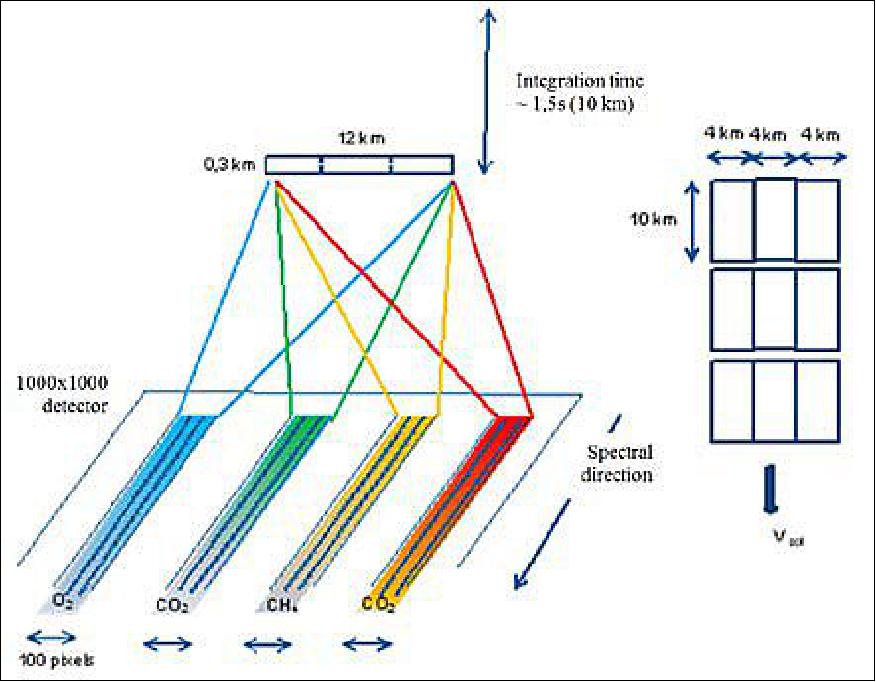
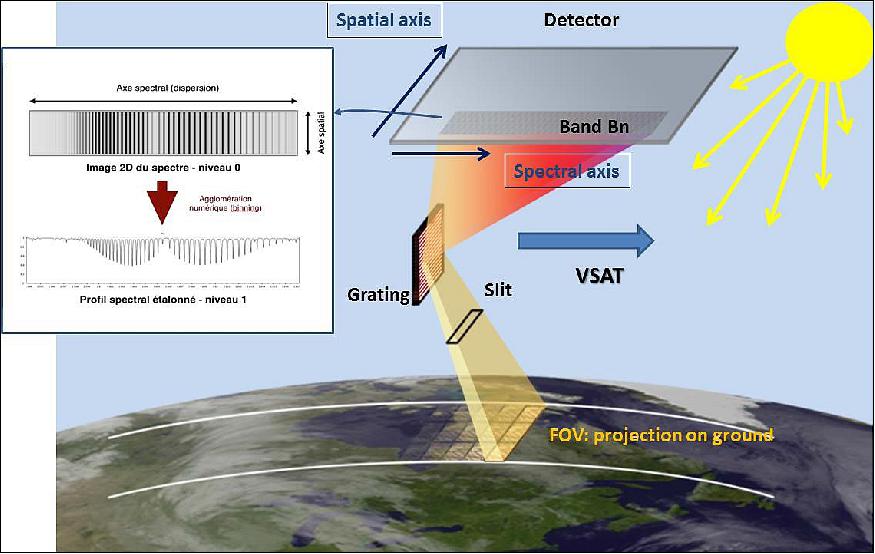
An entrance telescope forms the image at the level of the spectrometer entrance slit. That telescope is shared with an imager (operating at 0.625 µm) permitting to achieve cloud detection.
Calibration sources are implemented and will permit to check the stability of the instrument in orbit or re-calibrate if needed.
An electronic box permits to read out the detector, control and monitor the instrument, and format the telemetry data. All the data from the detectors are downloaded, no processing is implemented on–board.
Background: 20)
The measurement principle is based on the inversion of the spectral content of the area sounded. The instrument observes the Earth's atmosphere through three very narrow spectral windows. Its basic task is to accurately measure the spectral radiance reaching the TOA (Top Of Atmosphere). The light analyzed is from the sun, once bounced back off the Earth's surface at the targeted sounding point and absorbed by atmospheric gases—including CO2—and possibly scattered by atmospheric aerosols (Figure 18).
Carbon dioxide gas has absorption lines in the thermal infrared at 1.61 µm (band B2) and 2.06 µm (band B4). The sun's radiation at these wavelengths, reflected by the Earth back to the satellite, therefore contains the molecule's signature. It is the depth of the absorption lines that contains the information on CO2 concentration. An additional spectral band in the oxygen band at 0.76 µm, noted band B1, provides surface pressure data on spectrum inversion. This band also provides information on the contribution of atmospheric aerosols and fine clouds to the radiation collected by the onboard instrument. Data from this third band are taken into account when the CO2 spectra are inverted to enhance accuracy.
Above land, the satellite acquires measurements with a nadir line of sight. Above oceans, water being dark in the near-infrared and therefore not reflecting sunlight in a Lambertian way; MicroCarb will aim at the glint, i.e. the sun's specular reflectance. This capability of following the glint enables a large enough flux to be obtained at the instrument entrance, thus allowing atmospheric CO2 concentration to be measured above oceans.
The observation system is complemented by a two-dimensional imaging function at a wavelength of 0.625 µm to observe the sounded area. This 2D map of the sounded field accompanies each item of spectral data acquired by the instrument and will provide data upon clouds.
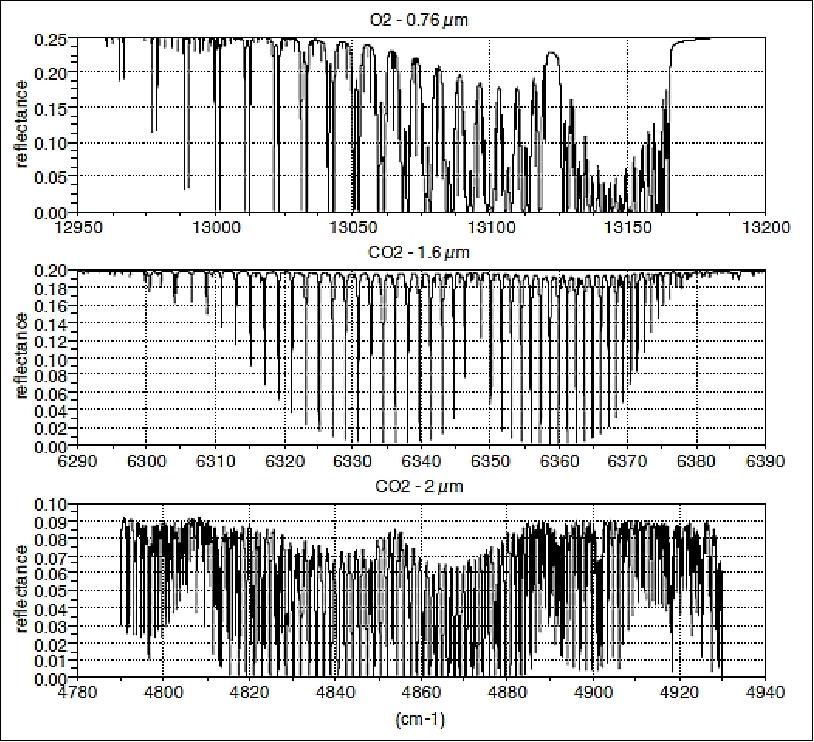
Spectrometer architecture and budgets (Ref. 10):
The payload allocations are very tight for this kind of instrument:
- the volume is limited by the launcher compatibility (the smallest case being the Soyuz-ASAP external position)
- the mass is limited by both structural constraints of the platform and the launcher compatibility: 72 kg
- the power is limited by the solar array capacity and the platform consumption: 57 W max.
The payload designed by Airbus Defense and Space (Figure 11) meets all these requirements with adequate margins.
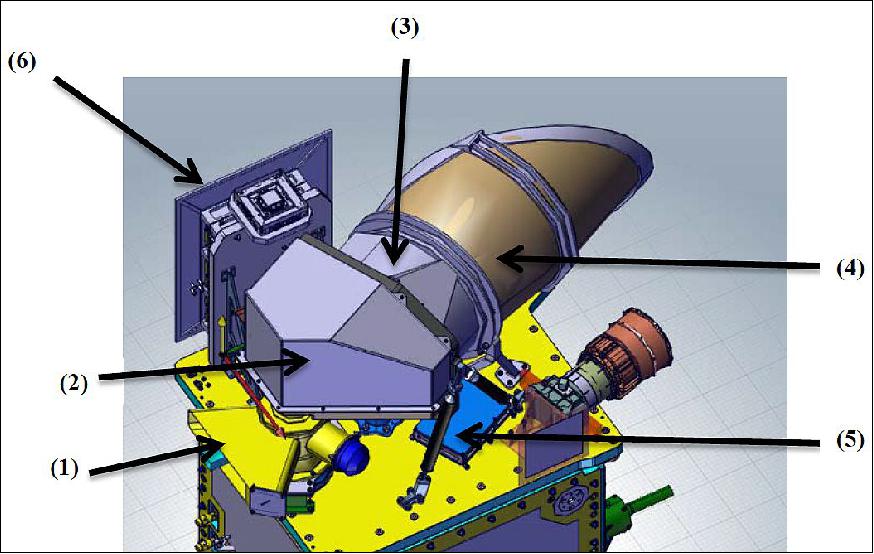
The instrument is composed of:
1) a pointing and calibration system: at the entry of the instrument, this system allows to change the line of sight of the instrument in order to point targets off track, in a ±25º range, and also allows to point towards calibration sources (lamps and sun through a specific slit)
2) a telescope to collimate the light coming from the Earth or from calibration sources
3) a spectrometer able to decompose the light according to its wavelength
- a large detector to measure the O2 and CO2 spectra
- a visible detector to image the ground in order to detect the clouds
4) a passive cooling system based on a two-stage circular radiator protected from external fluxes by a baffle
5) video electronics dedicated to each detector
6) one main electronic box in charge of power conditioning and sequencing of all the electronics and communication with the spacecraft bus.
All the optical parts are supported by a SiC (Silicon Carbide) optical bench attached to the platform panel with struts and flector. The use of SiC provides very good stability in orbit which is mandatory for this kind of instrument. The temperature reached by the passive cooling is close to 150 K for the detectors and 225 K for the spectrometer.
The MicroCarb mission is a challenging mission for a microsatellite (actually a minisatellite at 175 kg). The mission requires good agility and very good pointing accuracy and geolocalization performances. Thanks to an innovative instrument concept based on a single detector for spectrum measurement and efficient passive cooling, it has been possible to stay within the allocations of a 160 kg class satellite while meeting or even improving the performances of much bigger satellites currently in orbit or to be launched. The Myriade upgraded platform is able to embark on this instrument at a low cost and with high performance in all domains.
Table 3 shows the comparison in mass between CO2 measuring spacecraft in orbit or to be launched, together with gas and targeted accuracy showing that MicroCarb will be by far the smallest satellite for this purpose while providing equivalent or better measurement than these other projects.
Thanks to its small size and price, MicroCarb satellite can be a very good precursor to a constellation of satellites orbiting the Earth that would provide better spatial and temporal resolutions.
Spacecraft | Mass | Measured greenhouse effect gas | Targeted accuracy on CO2 |
GOSAT (launched in 2012 | 1750 kg | CO2 + others | 4 ppm |
OCO-2 (launched in 2014) | 450 kg | CO2 | 1 ppm |
TanSat (launch in Dec. 2016) | 500 kg | CO2 | 4 ppm |
MicroCarb (launch in 2021) | 175 kg | CO2 | 1 ppm |
References
1) F. Bermudo, P. Moro, V. Pascal, D. Pradines, C. Pierangelo, C. Deniel, FM. Bréon, "MicroCarb A Carbon Dioxide (CO2) Measurement Mission on Myriade Evolutions," Proceedings of the 4S (Small Satellites Systems and Services) Symposium, Portoroz, Slovenia, June 4-8, 2012
2) Clémence Pierangelo on behalf of Microcarb team: C. Deniel, F. Bermudo, V. Pascal, P. Moro, D. Pradines, S. Gaugain, F.-M. Bréon,"CNES concepts for microsatellites for CO2 observations," Satellite Hyperspectral Sensor Workshop, Miami, Virginia Key, Florida, USA, March 29-31, 2011, , URL: http://www.star.nesdis.noaa.gov/star/documents/meetings/Hyper2011/dayThree/0920Q11-Pierangelo.ppt
3) E. Pailharey, Philippe Martin, Eric Jauffraud, F. Bermudo, "MicroCarb, a sharp instrument for a small platform," Proceedings of the 4S (Small Satellites Systems and Services) Symposium, Portoroz, Slovenia, June 4-8, 2012
4) Eric Maliet, Charles Koeck, Claire Roche, Eric Beaufumé, Bruno Millet, François Bermudo, "Greenhouse gas monitoring missions from space," Proceedings of the 63rd IAC (International Astronautical Congress), Naples, Italy, Oct. 1-5, 2012, paper: IAC-12-B1.2.4
5) F. Bermudo, "MicroCarb Genral Status and Plans," Proceedings of the 8th International Workshop on Greenhouse Gas Measurements from Space (IWGGMS), Pasadena, CA, USA, June 18-20, 2012, URL: https://docs.google.com/file/d/0B-MSdNUpXGayeW5xYzdaYWtVYjA/edit?pli=1
6) F. Buisson and MicroCarb team, "Overview of the CNES / MicroCarb Atmospheric CO2 Monitoring Program," Proceedings of the IWGGMS-10 (10th International Workshop on Greenhouse Gas Measurements from Space) ESA/ESTEC, The Netherlands, May 5-7, 2014, URL: http://www.congrexprojects.com/2014-events/14c02/programme
7) "Towards a European Operational Observing System to Monitor Fossil CO2 emissions," European Commission, October 22, 2015, URL: http://edgar.jrc.ec.europa.eu/news_docs/CO2_report_22-10-2015.pdf
8) Francois Buisson, F. M. Breon, C. Deniel, "MicroCarb mission: a CNES initiative for monitoring the CO2 exchanges," IAA (International Academy of Astronautics) Climate Change and Disaster Management Conference, Mexico City, Mexico, Sept. 17, 2015
9) Réjane Ibos, Jean Jaubert, Didier Pradines, Arnaud Varinois, "MicroCarb Micro-Satellite: Mission and system analysis for pointing modes definition and constraints management," Proceedings of the 14th International Conference on Space Operations (SpaceOps 2016), Daejeon, Korea, May 16-20, 2016, URL: http://arc.aiaa.org/doi/book/10.2514/MSPOPS16
10) Arnaud Varinois, Didier Pradines, Francois Buisson, "MicroCarb: A microsatellite for atmospheric CO2 monitoring," Proceedings of the 14th International Conference on Space Operations (SpaceOps 2016), Daejeon, Korea, May 16-20, 2016, URL: http://arc.aiaa.org/doi/book/10.2514/MSPOPS16
11) MicroCarb Mission," CNES, Dec. 8, 2015, URL: https://microcarb.cnes.fr/en/MICROCARB/GP_mission.htm
12) Francois Buisson, Didier Pradines, Veronique Pascal, Denis Jouglet, "An introduction to MicroCarb, first European program for CO2 monitoring," International Working Group on Green house Gases Monitoring from Space, IWGGMS-12, Kyoto Japan, June 7-9, 2016, URL: https://www.omc.co.jp/iwggms12/pdf/Session_10/45_Francois_Buisson.pdf
13) Francois Buisson, Francois-Marie Breon, Carole Deniel, Véronique Pascal, Denis Jouglet, Didier Pradines, Pascal Prieur, Emilie Limasset, "The MicroCarb Project: an initiative for a global monitoring of the CO2 atmospheric concentration," Proceedings of the 70th IAC (International Astronautical Congress), Washington DC, USA, 21-25 October 2019, paper: IAC-19-B1.2.3, URL: https://iafastro.directory/iac/proceedings/IAC-19/IAC-19/B1/2/manuscripts/IAC-19,B1,2,3,x48834.pdf
14) "France-UK climate mission moves one step closer," UK Space, 22 December 2020, URL: https://www.ukspace.org/france-uk-climate-mission-moves-one-step-closer/
15) "Thales Alenia Space signs contract with the UK Space Agency to work on climate change mission," UKSA Press Release, 9 Nov. 2017, URL: https://www.gov.uk/government/news/thales-alenia-space-signs-contract-with-the-uk-space-agency-to-work-on-climate-change-mission
16) "UK Space Agency and CNES join forces to curb climate change," UKSA, 19 April 2017, URL: https://www.gov.uk/government/news/uk-space-agency-and-cnes-join-forces-to-curb-climate-change
17) "CNES selects Airbus DS to build MicroCarb payload to map CO2 levels," Airbus DS Press Release, April 13, 2016, URL: https://airbusdefenceandspace.com/wp-content/uploads/2016/04/press-release-microcarb-en.pdf
18) "Arianespace to launch Microcarb on Vega C," Arianespace Press Release, 18 January 2022, URL: https://www.arianespace.com/press-release/arianespace-to-launch-microcarb-on-vega-c/
19) Information provided by Francois Buisson of CNES
20) Veronique Pascal, Christian Buil, Elodie Cansot, Jacques Loesel, Laurie Tauziede, Clemence Pierangelo, François Bermudo, Mathieu Olivier, Mickael Dubreuil, "A new space instrumental concept based on dispersive components for the measurement of CO2 concentration in the atmosphere," Proceedings of the ICSO (International Conference on Space Optics), Ajaccio, Corse, France, Oct. 9-12, 2012, paper: ICSO-129, URL: http://congrex.nl/icso/2012/papers/FP_ICSO-129.pdf
The information compiled and edited in this article was provided by Herbert J. Kramer from his documentation of: "Observation of the Earth and Its Environment: Survey of Missions and Sensors" (Springer Verlag) as well as many other sources after the publication of the 4th edition in 2002. - Comments and corrections to this article are always welcome for further updates (eoportal@symbios.space).
Spacecraft Mission Status Launch Sensor Complement References Back to top